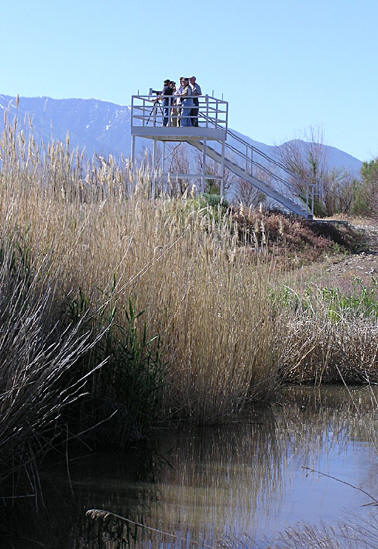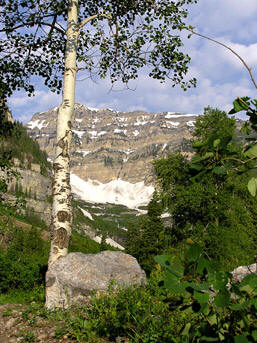Utah County Birders Newsletter
|
 |
|
Alton, Lu and Bob at Ouray NWR - June 4, 2005 photo by Eric Huish |
Three hardy souls met at 5:00 a.m. on Saturday morning (June 4th) to make the
trip to Ouray. The sound of killdeer and a common nighthawk in the darkness
overhead augured well. Our group number later doubled as we met three more
birders at Ouray shortly before 8 a.m.
The Green River is very high and has inundated much of the Leota bottoms area.
Units that were completely dry three weeks ago are now flooded, and some areas
that are normally just marshy are under several feet of water. It was apparent
that, high as the water in the unit is, that it has receded some 12-18" over the
last few days. Some of the dikes we had hoped to walk were impassible as we had
neglected to bring our swim fins. The Sheppard bottoms area (the auto tour loop)
also had water
levels that seemed higher than normal in some areas. But all in all there was
plenty of good habitat for the numerous birds we observed.
Early in the afternoon we drove back up the road to Pelican Lake. The water
level here was also higher than that observed in mid-May, but it was not as
dramatically high as at Ouray. We spent several hours exploring the area.
It was our good fortune to get good looks at both our target birds, American
bitterns and black terns. The weather was beautiful, the bugs were not too bad,
and the company was great.
p.s. - if you visit Ouray be on the look-out for a yellow-billed cuckoo in the
cottonwoods between the boat ramp and the 1st Leota bottoms gate. We thought we
heard one but could never find it; the water levels beneath and around the trees
prevented us from a thorough search.
Participants: Eric Huish, Bonnie Williams, Alton Thygerson, Artis Thygerson, Bob
Bradley and Lu Giddings.
Partial trip list (79 spp): Pied-billed Grebe, Eared Grebe, Western Grebe,
American White Pelican, Double-crested Cormorant, American Bittern, Great Blue
Heron, Black-crowned Night Heron, Snowy Egret, White-faced Ibis, Turkey Vulture,
Canada Goose, Gadwall, Mallard, Blue-winged Teal, Cinnamon Teal, Northern
Shoveler, Northern Pintail, Green-winged Teal, Redhead, Lesser Scaup, Ruddy
Duck, Northern Harrier, Red-tailed Hawk, Golden Eagle, American Kestrel,
Ring-necked Pheasant, California Quail, Virginia Rail, American Coot, Killdeer,
Black-necked Stilt, American Avocet, Willet, Spotted Sandpiper, Wilson's
Phalarope, Franklin's Gull, Ring-billed Gull, Forster's Tern, Black Tern,
Mourning Dove, Common Nighthawk, White-throated Swift, Northern Flicker, Western
Wood-Pewee, Willow Flycatcher, Western Kingbird, Eastern Kingbird, Loggerhead
Shrike, Plumbeous Vireo, Black-billed Magpie, Common Raven, Horned Lark,
Violet-green Swallow, Northern Rough-winged Swallow, Cliff Swallow, Barn
Swallow, House Wren, Rock Wren, Marsh Wren, Blue-gray Gnatcatcher, Mountain
Bluebird, American Robin, European Starling, Yellow Warbler, Common
Yellowthroat, Yellow-breasted Chat, Spotted Towhee, Lark Sparrow, Savannah
Sparrow, Black-headed Grosbeak, Blue Grosbeak, Lazuli Bunting, Red-winged
Blackbird, Western Meadowlark, Yellow-headed Blackbird, Brown-headed Cowbird,
Bullock's Oriole, American Goldfinch.
------------------------------------------------------
 |
|
Utah County Birders on Viewing Tower at 4000 West Lake Shore Sportsman Access - June 18, 2005 photo by Eric Huish |
Field Trip Report
River Lane and Lincoln Point - June 18, 2005
by Carol Nelson
Being unable to participate with the birders on many of their field trips
this year, Saturday's trip was a delight for me. It reacquainted me with some of
God's most beautiful creations, birds and birders. I had fun just standing there
holding my binoculars. We added Benjamin slough and 4000 West to our anticipated
birding areas. The fact that 4000 West has water again was an added bonus. Some
of the highlights follow.
We picked up the Eurasian Collared-Dove on the barn at the beginning of River
Lane, a Great Horned Owl and a Blue Grosbeak down further. The Blue Grosbeak
reappeared at 4000 West. Milt's ever-present scope found an Osprey sitting on a
nest and someone's sharp eyes pulled a Wilson's Phalarope out of the stands of
weeds in the fields at 4000. We also saw an Eastern Kingbird there. At Benjamin
slough I was reminded that birders don't just scan the ponds and poles, they
also check the heavens. "Up, up in the sky" a Black-crowned Night-Heron, a
Caspian Tern, and a Common Nighthawk did a quick fly over. Bonnie and Alona's
sharp eyes rewarded us with a Short-eared Owl at Lincoln Beach. We were 12 in
number and ended up with a trip list of 54 species. Perhaps if we all had the
sharp ears and mind of Eric Huish we would have had more. He heard 10 species we
could never locate. I, personally, would like to thank all those who faithfully
lead the trips, put together the newsletter and make our meetings interesting.
In my eyes, they're great!
------------------------------------------------------
 |
|
Timp. Trail Head at Aspen Grove
- June 25, 05 |
Field Trip Report
Aspen Grove - June 25, 2005
by Grant Jense
Eric Huish led a group of nine Utah County Birders on a bird walk on June
25th in the Aspen Grove - Stewart Falls area. We met at 7 a.m. at the mouth of
Provo Canyon and were greeted by a cool wind coming down the canyon.
It was a very pleasant and sunny morning by the time we reached the trialhead
parking lot at Aspen Grove. The canyon is very green and lush with vegetation
this year. We saw more water running down the streams and hillsides than I
have seen in years. We watched for birds around the trailhead parking lot and
then walked most of the way to Stewart Falls. There was some snow remaining on
the trail and there were areas were avalanches had knocked down trees this past
winter.
The birds were enjoying the morning as much as we were and were actively
singing. We never saw a large number of birds, but were able to see several of
the resident nesting species such as: Western Tanager, Black-headed Grosbeak,
Orange-crowned and MacGillivray’s Warblers, Chipping and Fox Sparrows, Cliff
Swallows, White-throated Swifts, Red-breasted Nuthatch, Mountain Chickadee,
Broad-tailed Hummingbird, Warbling Vireo, Ruby-crowned Kinglet, Northern
Flicker, Red-naped Sapsucker, Swainson’s and Hermit Thrushes, American Robin,
Dark-eyed Junco, Bullock’s Oriole (mouth of Provo Canyon) and two unidentified
Empid Flycatchers. Also - Steller’s Jays were heard calling from the slopes
above us on several occasions.
The group also enjoyed identifying various wildflowers, shrubs, trees and
butterflies. In all, it was a very pleasant field trip.
Backyard Bird of the
Month
June 2005
Steve Carr - Holladay
Lesser Goldfinch - small flock still present since February.
KC Childs - Orem
Brown-headed Cowbird - Second one ever.
Wade Covert - Provo
Lesser Goldfinch - I’ve had more Lessers lately.
Eric Huish - Pleasant Grove
White-throated Swift - Fly over, yard bird # 88.
Milt Moody - Provo
Baby Robin - Chasing it’s parent -begging for food.
Cheryl Peterson - Provo
Cute little Pine Siskin begging for food from its parents.
Tuula Rose - Sipoo, Finland
A tie between a Blue Tit with a nestbox full of young and a Robin
( the original kind) singing the sweetest song high in a tall fir tree.
Dennis Shirley - Los Quetzales Lodge, Panama
Oscellated Antbird - Following an ant swarm, catching bugs moved by the
ants.
Carolyn Shirley - Los Quetzales Lodge, Panama
Harpy Eagle - Seen from the Canopy Tower while Dennis was off birding.
Reed Stone - Provo
Lesser Goldfinch - Gleaning spiderwebs from windows for nests.
Alton Thygerson - Provo
Broad-tailed Hummingbirds
Bonnie Williams - Mapleton
Olive-sided Flycatcher - New for year.
We would like you to share your favorite backyard bird each
month. Please send your favorite bird at the end of the month to
newsletter@utahbirds.org or call 360-8777. If you would like a reminder at
the end of the month e-mail the above address.